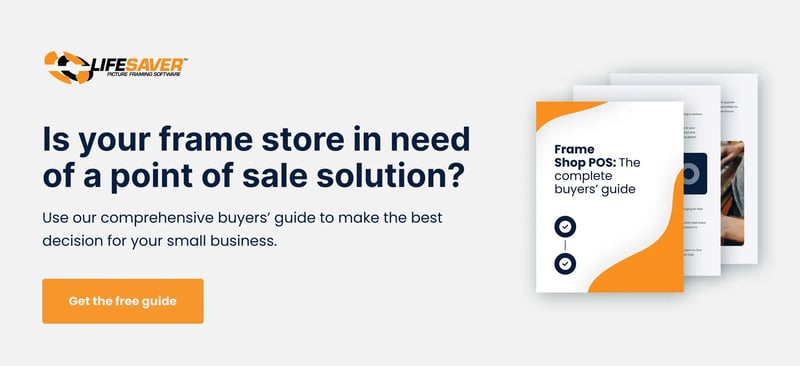
You’ve mastered the art of framing — now it’s time to frame your future. Turning your passion into a thriving business takes more than talent behind the mat cutter. It takes vision, strategy, and a rock-solid plan.
Ready to go from workshop wizard to shop owner? Learning how to write a custom framing business plan is your first big step. From nailing down your niche to mapping out your pricing, services, and growth goals, we’ve broken it down into six simple, actionable steps to help you build a business that’s as strong as your corners.
Step 1: Define What You Do — and Why It Matters
Start by writing a custom framing business plan with a clear, no-nonsense summary of what you do. Think of it as your elevator pitch — quick, catchy, and easy for anyone (even non-framers) to understand in seconds.
When writing it out, focus on these critical details:
-
Describe your core services: Specify the types of custom framing you offer, such as fine art, photography, diplomas, jerseys, or shadow boxes. Mention whether you provide conservation framing, oversized pieces, or gallery installations.
-
Highlight your location: Are you tucked into an arts district, part of a busy suburban plaza, or operating only online? Make it clear where (and how) customers will find you.
-
Identify your ideal customer: Define your audience, whether it’s local artists, galleries, homeowners, businesses, or collectors.
This section sets the tone for the rest of your plan and positions you for growth. Be clear and confident — this is your opportunity to define how others perceive your business.
Step 2: Get Specific on Your Ideal Customer
When you know exactly who you’re framing for, everything else — pricing, services, marketing — falls into place. The goal? Paint a clear picture so anyone reading your plan can instantly visualize your target customer.
You should:
-
Define your customers: Describe who you serve, like local artists, galleries, homeowners, interior designers, or collectors.
-
Outline demographic traits: Identify age ranges, income levels, and whether you’re targeting locals, regional buyers, or online shoppers.
-
Determine buying behaviors: Highlight what motivates people to purchase, such as a preference for craftsmanship, the need for preservation, or gifting occasions.
This part of your business plan should highlight what makes your store and services appealing to potential customers and encourage them to return for future projects.
Step 3: Size Up the Competition
Knowing who else is in the custom framing industry — and how you’ll do it differently — gives you an edge. Conduct a focused competitive analysis to find gaps, sharpen your strategy, and highlight what sets you apart.
To review competitors in the following areas, you should:
-
Research local frame shops: Visit nearby stores to assess their pricing, turnaround time, customer service, and in-store experience.
-
Evaluate big-box and craft stores: Analyze their framing services, promotions, and limitations — for example, standard sizes, upsell pressure, and lack of customization.
-
Review online framing services: Study digital platforms and online framing trends to determine how they compare in convenience, price, and packaging.
To build a successful picture framing business, look beyond surface-level comparisons. Study what competitors do well, where they fall short, and where gaps exist — like eco-conscious options or specialty services they don’t offer.
This isn’t just about staying competitive. You need to establish your shop as the trusted choice for customers seeking high-quality services.
Step 4: Set Up Your Marketing Plan
If people don’t know your frame shop exists, they won’t walk through the door — or click “buy.” That’s why marketing is an integral part of your business plan. It shows how you’ll turn your shop into a local favorite (or a competitive player online).
Focus on strategies that attract your ideal customers and make them want to come back for more:
-
Get involved in your community: Attend local art shows, sponsor gallery events, or collaborate with interior designers to get your name in front of people interested in your products.
-
Use social media advertising: Post before-and-after shots of custom projects, behind-the-scenes framing work, and tips on frame styles. Make it personal and visually engaging.
-
Reward referrals and loyalty: Launch a referral program for happy customers and offer small incentives for repeat business, including discounts or exclusive previews before the final product is complete.
Every marketing move should answer one question: Why your store? With strong messaging and the proper visibility, your custom frame store will become something customers remember (and recommend).
Step 5: Plan Your Operations and Finances
It’s easy to get caught up in the vision of your framing store when crafting your plan — but vision alone isn’t enough. Your plan should describe how the shop will run day to day, and the financial projections should show how you’ll turn a profit.
Start with the basics of your shop operations:
-
Set your hours and roles, including handling customer service and peak periods.
-
List the tools and equipment you’ll use.
-
Name your material suppliers after carefully considering vendors.
-
Describe your workflow approach for custom orders and rush jobs.
Next, map out your financials:
-
Estimate startup costs like rent, display fixtures, tools, inventory, and business licenses.
-
Project monthly income and expenses like labor, utilities, supplies, marketing, and rent.
-
Outline your pricing model with details on how you’ll price various services, like basic framing, conservation upgrades, or shadow boxes.
Set a realistic breakeven timeline, outlining when you expect to cover your costs and start making profits.
Step 6: Wrap Up With a Strong Executive Summary
The executive summary is the last step in writing your custom framing business plan — it’s your big-picture snapshot. This section pulls everything together and highlights what makes your business worth investing in.
Think of it as your go-to reference as your business grows — and a valuable tool for lenders, partners, or future investors looking for a clear, compelling overview.
To write an effective executive summary:
-
Summarize your business: Highlight key products and services, your target market, and what differentiates your shop.
-
Define your target market: Identify your core customers and explain what they value most.
-
Explain your competitive advantage: Show how your services, pricing, framing workshops, or custom offers outshine local and online competitors.
-
Outline your financial highlights: Share startup costs, pricing structure, and when you expect to break even.
-
Describe your growth plan: Map out where you see the business in one, three, and five years — whether offering new services, setting up a second location in a high-traffic area, or an e-commerce expansion.
Your executive summary adds impact to your business plan by clearly and confidently communicating your vision.
How To Write a Custom Framing Business Plan That Works for You
Learning how to write a custom framing business plan is one thing, but putting that plan into motion takes more than good ideas. You need tools built to help your business succeed.
With LifeSaver’s framing point of sale (POS) system, you can create detailed quotes, manage organized work orders, and process payments without juggling multiple systems. Built-in vendor integrations connect with your moulding, matting, and glass suppliers to simplify inventory tracking and reordering.
You also get reports to track costs, revenue, and inventory levels — giving you live insights into profitability and performance. And to take your service to the next level, send quotes, receipts, and appointment reminders via text and request reviews automatically after orders are fulfilled.
With FrameVue, you can generate digital mockups of custom orders before a frame is cut, helping customers visualize their purchase and improving buyer confidence.
Start your free LifeSaver trial today and turn your custom framing business plan into tangible, measurable results.

Apr 17, 2025 5:01:33 PM



